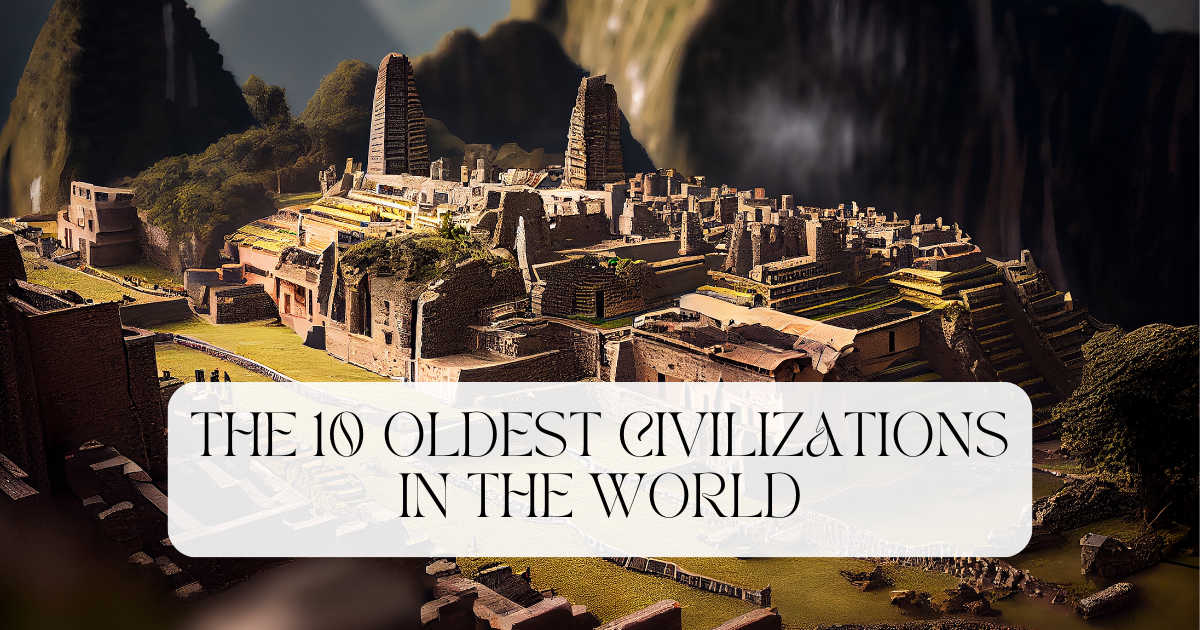Civilization refers to a complex society characterized by advanced social, economic, and cultural development. It is often marked by the emergence of written language, the development of agriculture, and the establishment of cities. Over the course of human history, there have been numerous civilizations that have risen and fallen, leaving behind a rich legacy of achievements and cultural treasures. In this blog, we will take a journey through time and explore the 10 oldest civilizations in the world.
-
Sumerian Civilization (4500 BCE)
The Sumerian civilization emerged in Mesopotamia (present-day Iraq) around 4500 BCE, making it one of the oldest known civilizations in the world. The Sumerians were responsible for many technological innovations, including the wheel, the plow, and the first known form of writing. They also developed complex religious and political systems and created impressive works of art and architecture, such as the ziggurat temples and the city of Ur.
-
Norte Chico Civilization (3500 BCE)
The Norte Chico civilization flourished along the coast of Peru from around 3500 BCE to 1800 BCE. Although little is known about this civilization, archaeologists have discovered impressive examples of urban planning and monumental architecture, such as the Caral-Supe complex. The Norte Chico people were also skilled at agriculture, using innovative techniques to irrigate their crops in a desert environment.
-
Indus Valley Civilization (3300 BCE)
The Indus Valley civilization emerged in present-day Pakistan and India around 3300 BCE and flourished until around 1300 BCE. This civilization was notable for its advanced urban planning and sanitation systems, as well as its intricate system of writing, which has yet to be fully deciphered. The Indus Valley people also had a rich artistic tradition, creating beautiful sculptures, pottery, and jewelry.
-
Egyptian Civilization (3100 BCE)
The ancient Egyptian civilization is one of the most well-known and studied in the world. It emerged in the Nile River valley around 3100 BCE and lasted until the Roman conquest in 30 BCE. The Egyptians were skilled engineers and architects, creating impressive structures such as the pyramids and the Great Sphinx. They also had a complex religious system and a rich artistic tradition, producing magnificent works of sculpture, painting, and jewelry.
-
Minoan Civilization (2700 BCE)
The Minoan civilization emerged on the island of Crete in the Mediterranean around 2700 BCE and flourished until around 1450 BCE. The Minoans were renowned for their maritime trade and seafaring skills, as well as their impressive art and architecture. The palace of Knossos, with its intricate frescoes and colorful decorations, is one of the most impressive examples of Minoan architecture.
-
Akkadian Civilization (2334 BCE)
The Akkadian civilization emerged in Mesopotamia around 2334 BCE and lasted until around 2154 BCE. The Akkadians are known for their military prowess and their conquests of neighboring territories. They also had a highly developed system of writing, using cuneiform script, and created impressive works of art, such as the stele of Naram-Sin.
-
Chinese Civilization (2100 BCE)
The Chinese civilization emerged along the Yellow River valley in present-day China around 2100 BCE and lasted until the present day. The Chinese civilization has a rich and complex history, marked by numerous dynasties, inventions, and cultural achievements. The Chinese are known for their impressive technological innovations, such as the invention of paper, printing, and gunpowder. They also have a rich artistic tradition, producing exquisite works of calligraphy, painting, and sculpture.
-
Mayan Civilization (2000 BCE)
The Mayan civilization emerged in present-day Mexico and Central America around 2000 BCE and flourished until the Spanish conquest in the 16th century. The Mayans were skilled astronomers, mathematicians, and builders, creating impressive structures such as the pyramids and the temple complexes at Chichen Itza and Tikal. They also had a highly developed system of writing, using hieroglyphics, and produced remarkable works of art, including intricately carved stone monuments and pottery.
-
Babylonian Civilization (1894 BCE)
The Babylonian civilization emerged in Mesopotamia around 1894 BCE and lasted until the Persian conquest in 539 BCE. The Babylonians are known for their impressive contributions to astronomy, mathematics, and law. They created the first known code of law, the Code of Hammurabi, and developed a highly sophisticated system of mathematics, including the concept of zero. The Babylonians also produced impressive works of art and architecture, such as the Ishtar Gate.
-
Olmec Civilization (1400 BCE)
The Olmec civilization emerged in present-day Mexico around 1400 BCE and lasted until around 400 BCE. The Olmecs are known for their impressive stone sculptures and their contributions to Mesoamerican civilization. They developed a complex system of writing, using hieroglyphics, and created impressive works of art, such as the colossal stone heads found at the Olmec site of La Venta.
Summary of the 10 Oldest Civilizations in the World: Location, Time Period, and Achievements:
| Civilization | Location | Time Period | Major Achievements |
|---|---|---|---|
| Sumerian | Mesopotamia | 4500 - 2000 BCE | Invented writing, developed complex city-states, created impressive architecture and art |
| Norte Chico | Peru | 3500 - 1800 BCE | Built large urban centers, developed impressive agricultural systems, had a complex religious and ceremonial life |
| Indus Valley | South Asia | 3300 - 1300 BCE | Created complex urban settlements, had a highly developed system of writing and trade, built impressive public works such as the Great Bath |
| Egyptian | Egypt | 3100 - 30 BCE | Built impressive pyramids, developed a highly sophisticated system of writing and art, had a complex religious and political system |
| Minoan | Crete | 2700 - 1450 BCE | Created impressive palaces and buildings, had a highly developed system of writing and art, were skilled seafarers |
| Akkadian | Mesopotamia | 2334 - 2154 BCE | Created the first empire in world history, developed a highly sophisticated system of writing and trade, made significant advancements in art and architecture |
| Chinese | China | 2100 BCE - present day | Invented paper, printing, and gunpowder, developed a highly sophisticated system of mathematics and astronomy, produced exquisite works of calligraphy and art |
| Mayan | Mexico and Central America | 2000 BCE - 16th century CE | Built impressive pyramids and temple complexes, had a highly developed system of writing and art, were skilled astronomers and mathematicians |
| Babylonian | Mesopotamia | 1894 - 539 BCE | Created the first known code of law, the Code of Hammurabi, developed a highly sophisticated system of mathematics and astronomy, produced impressive works of art and architecture such as the Ishtar Gate |
| Olmec | Mexico | 1400 - 400 BCE | Created impressive stone sculptures and monuments, developed a complex system of writing and art, made significant contributions to Mesoamerican civilization |
Conclusion:
The 10 oldest civilizations in the world have left behind a rich legacy of achievements and cultural treasures. From the technological innovations of the Sumerians and Chinese to the impressive architecture of the Egyptians and Mayans, these civilizations have contributed greatly to the development of human civilization. Their contributions to art, science, and culture continue to resonate today, reminding us of the enduring legacy of these ancient societies.
Discover More
Most Viewed
Christmas is a season of joy, love, and traditions. And what better way to get into the holiday spirit than through timeless carols? These musical gems have been bringing people together for generations. Here’s our ranked list of the Top 10 Christmas Caro…
Read More

















